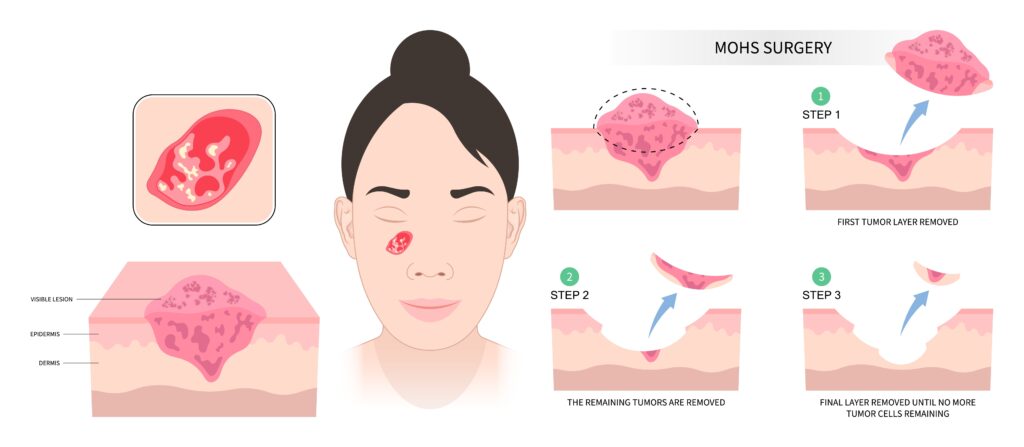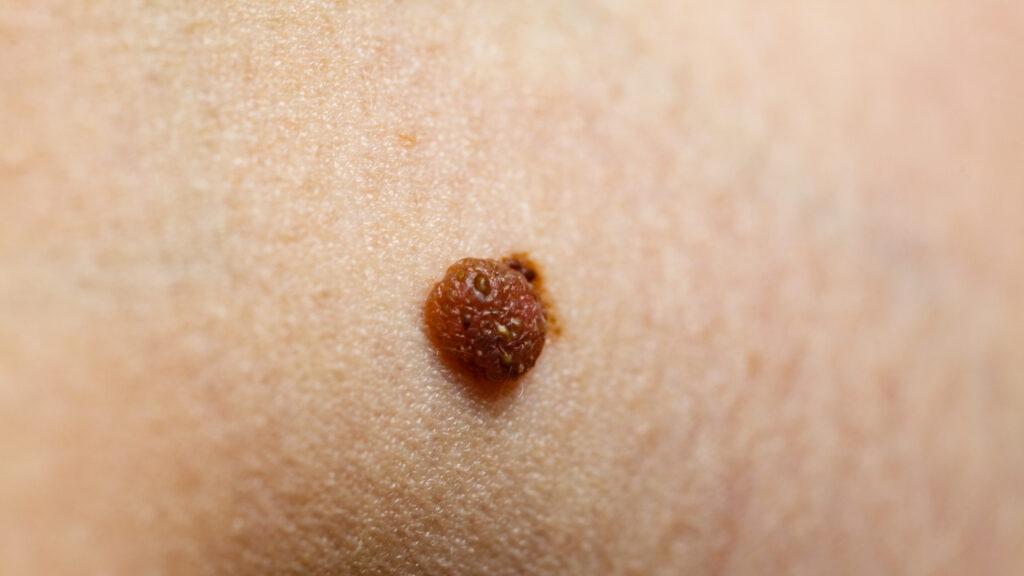Mohs surgery, also known as Mohs micrographic surgery, is a highly effective and precise technique for removing certain types of skin cancer. Developed by Dr. Frederic Mohs in the 1930s, this approach offers a high cure rate while minimizing the amount of healthy tissue removed.
Calkin & Boudreaux utilizes Mohs surgery to provide patients with the best possible outcomes for skin cancer removal.
What Is Mohs Surgery?
Mohs surgery differs from traditional skin cancer surgery in its unique tissue removal and examination approach. Here’s what sets it apart:

Layer-by-Layer Removal
Unlike traditional skin cancer surgery that removes the visible tumor at once, Mohs surgery involves removing thin layers of tissue one at a time.
Microscopic Examination
After removing each layer, it’s immediately frozen, processed, and examined under a microscope by a specially trained Mohs surgeon. This allows your Calkin & Boudreaux surgeon to precisely identify any remaining cancer cells.
Tissue Mapping
The removed tissue is meticulously mapped, ensuring your surgeon knows the exact location of any cancerous cells. This detailed process allows for the complete removal of cancerous tissue while preserving as much healthy skin as possible. Mohs surgery could be beneficial for:
Skin Cancers with Unclear Margins
When the borders of the cancerous area are difficult to distinguish from healthy tissue, Mohs surgery ensures complete removal without unnecessary tissue loss.
Aggressive Skin Cancers
Mohs surgery provides a higher cure rate for certain types of skin cancer that are more likely to recur.
Cosmetically Sensitive Areas
This approach is ideal for removing skin cancer on the face, ears, nose, or hands, where preserving a natural appearance is crucial.
What to Expect During Mohs Surgery
Mohs surgery is typically performed as an outpatient procedure in a doctor’s office or clinic setting. You can expect the following during Mohs surgery at Calkin & Boudreaux:
Preparation
The area to be treated will be cleansed and numbed with a local anesthetic.
First Tissue Removal
Your Mohs surgeon will remove the visible tumor and a thin margin of surrounding tissue.
Tissue Processing
The removed tissue will be processed, frozen, and prepared for microscopic examination.
Microscopic Analysis
While you wait comfortably, your surgeon will examine the tissue under a microscope to determine if any cancer cells remain.
Repetition of Steps (as necessary)
If cancer cells are found at the edges of the removed tissue, your surgeon will repeat steps 1-4, removing additional tissue. This process continues until all margins are clear of cancer.
Wound Repair
Once all cancerous tissue is removed, they will close the wound using stitches, skin flaps, or grafts, depending on its size and location. Mohs surgeons have specialized training in closures to minimize scarring. The entire procedure can take one to several hours, depending on the case’s complexity.
Recovering After Mohs Surgery
Following Mohs surgery, you can expect swelling, redness, and discomfort in the treated area. Your doctor at Calkin & Boudreaux will provide specific instructions on caring for the wound, including:
Wound Cleaning and Dressing Changes
Proper wound care is essential to prevent infection and promote healing.

Pain Management
Over-the-counter pain medication can typically manage any discomfort.
Sun Protection
Protecting the treated area from the sun is crucial to promote healing and minimize scarring. Most patients experience minimal scarring after Mohs surgery.
However, the extent of scarring depends on the size and location of the treated area. Your doctor can discuss options for minimizing scarring, ranging from silicone gel sheets to cosmetic treatments such as Fraxel.
Mohs surgery offers a safe and effective way to remove skin cancer with excellent cure rates and minimal cosmetic impact. If Mohs surgery has been recommended to you by your dermatologist or primary care physician, discuss this option with your dermatologist at Calkin & Boudreaux in Sacramento, CA, to learn more about how it could be the right treatment approach for you.
